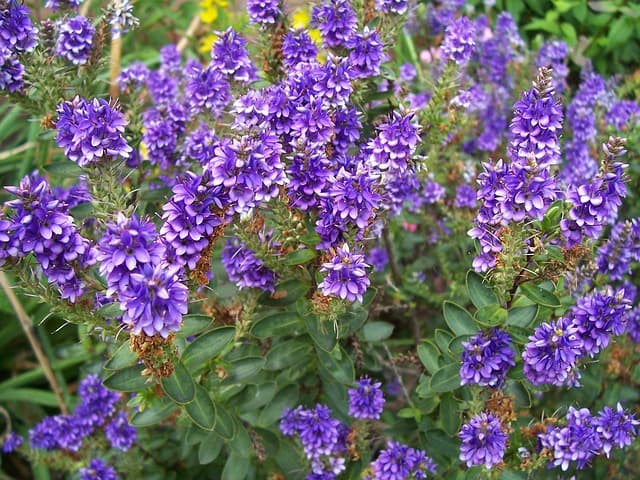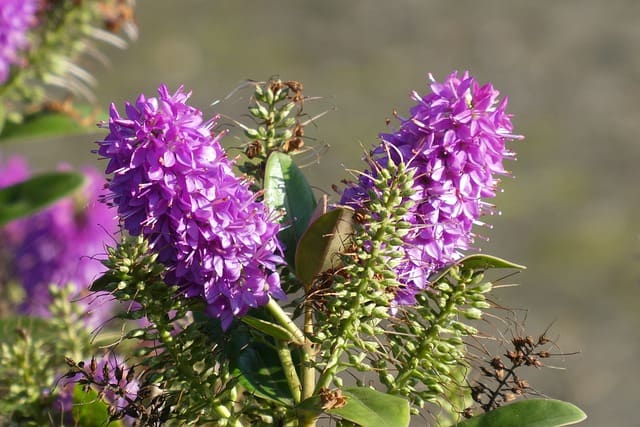Hebe plant dies mainly due to Root rot. Leaf Spot Disease, underwatering, or lack of sunlight can also kill your Hebe shrub. Vine Weevils, Leafcutter bees, and Caterpillars feed on Hebe leaves.
Hebe plants are grown in gardens for their beautiful flowers and foliage. The flowers are spiked and they look awesome!
Hebe plants can easily thrive in many conditions and are easy to maintain. But these plants can run into some issues too.
Some pests like Vine Weevils, Leafcutter bees, or Caterpillars may also damage the plant.
Why is my Hebe going brown?
Root rot causes Hebe leaves to turn brown and stems to die back. Septoria leaf spot disease causes brown spots on Hebe leaves. Sun scorching and underwatering cause brown leaves on Hebe too.
Let’s see why leaf browning is seen and how to fix the issue.
Hebe Root Rot
Root rot is caused when Hebe plant is overwatered and the soil becomes soggy. Poor soil conditions and lack of drainage in the soil cause Root rot.
Such waterlogged conditions are favorable for the growth of fungi. These fungi grow in the roots rotting them.
The entire stem including the leaves turns brown and dies back. Dig up the plant and you’ll see that the roots are rotten. The plant becomes stunted.
Destroy the affected plants and replace the soil with fresh, nutrient soil. Plant a new plant in better soil conditions.
Brown Spots on Hebe Leaves (Leaf Spot Disease)
Sometimes people see brown spots on Hebe leaves. People call this disease Septoria Leaf Spot disease. Small brown spots are seen on the leaves.
If left untreated this disease reduces the vigor of the plant and growth slows down.
Symptoms appear in October-February. Sometimes symptoms are seen early, in June.
To treat: Treat the affected plant with a general-purpose fungicide as soon as you see the symptoms. Apply twice or thrice a year. Two applications at fortnightly intervals are recommended.
Sunlight
Too much sunlight can scorch the leaves. Leaves become brown and crunchy. This happens especially in the summer season.
If the browning is only on one side, it is probably sunburn. Shade the plant with a shade cloth during the warmer times of the day.
Underwatering
Not only overwatering, but underwatering can also cause browning of the leaves too. Check the soil near the roots with a stick or fingers. If it’s moist, you probably overwatered it.
If the root ball goes dry, the roots can not absorb nutrients anymore. This situation reflects in the leaves.
To fix: You need to water the plant abundantly. Apply a layer of organic mulch.
Tip: Is the rootball dry and repelling water? Use 1 tsp liquid soap in 2 gal. of water and irrigate the plant slowly.
My Hebe is not flowering
The primary reason why Hebe fails to bloom is hard pruning. Careless pruning or pruning during the wrong time of the year is the reason.
- If the part from where the flowers grow is cut off then the shrub fails to flower. Take good care when pruning Hebe shrub.
- Too much nitrogen in the soil also affects blooming in Hebe.
- Hebe fails to flower if you haven’t pruned the shrub for years. Prune properly and at the right time.
- The best way to prune this shrub is right after flowering. Prune only the green, flexible parts, avoid pruning the woody growth.
- They need enough sunlight(6 hrs+) to bloom properly.
What is eating my Hebe?
Vine Weevils, Leafcutter bees, and Caterpillars eat Hebe leaves. They need to be identified early for minimal damage.
Leafcutter bees leave large, round holes in leaves. Vine Weevils leave smaller, notched holes in the foliage. Caterpillar damage can be identified by spotting excreta on the lower parts of the leaves.
Identify the pest correctly and then treat it accordingly. Use sticky traps and Diatomaceous Earth to get rid of Vine Weevils.
The best way to get rid of Caterpillars is by picking them by hand and disposing of them in the soap solution.
Why is my Hebe losing leaves?
Hebe plant is losing leaves either because the rootball is completely dried up or due to root rot.
If the roots are dried up, water them adequately. If the roots can’t absorb water anymore, try giving them dilute soap water.
Frequently Asked Questions
Let’s look at some of the frequently asked questions now. These questions are mailed to me by some of the blog followers.
Do Hebes die in winter?
Hebes survive in mild winters, however, they may die in freezing winters.
How often should I water my Hebe?
Water once a month in spring and fall. In Summer water the plant twice a month with some plant food if the plant is in the growing stage.
Does Hebe like the sun or shade?
Hebe likes full sun but it also can thrive in partial shade. Ensure that the soil has good drainage.


